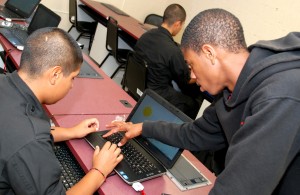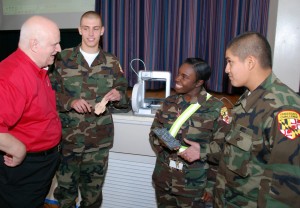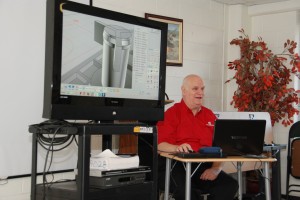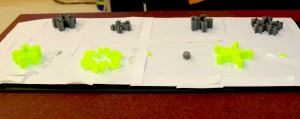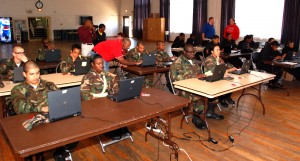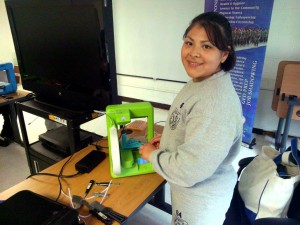There are some very special ornaments on display this Christmas season in the homes of the teenagers who completed the latest 3D ThinkLink Initiative classes sponsored by The YouthQuest Foundation at Freestate and Capital Guardian Youth ChalleNGe Academies.
As a final assignment, YouthQuest Training Director Tom Meeks had the Cadets in the Maryland and District of Columbia ChalleNGe programs use their imaginations to design and fabricate any kind of ornament they could dream up. The idea was to encourage them to be creative and to produce something meaningful they could take home to their families after graduation.
Some of the ornaments are reflections of the changes these at-risk teens have gone through during the 22-week residential programs operated by the National Guard Youth ChalleNGe Foundation.
Perhaps the most poignant creation is Capital Guardian Cadet Dalonta Crudup’s ornament.
He wanted to make something that “would just stand out.” His inspiration came from his best friend, Malik Spears – know to all as “Wiz” – who was fatally shot in Northeast DC this summer, just before Dalonta entered the ChalleNGe program.
“This is like a tombstone,” he said, holding the circular object that bears a heartfelt message. “I made this to show appreciation from me to his family.”
“He was like a brother and I was always with him every single day,” Dalonta explained. “It says: Rest in Peace, Wiz. We miss you. We thought of you with love today but that is nothing new. We thought about you yesterday and the days before that too.”
Some of Dalonta’s fellow Cadets from the District of Columbia also knew Wiz.
“It meant a lot to the class,” he said. Although it was “very hard” to complete the project, when his classmates saw what he’d done, they realized they could come up with their own creations, too.
“It was a lot of steps. We had to keep switching it to get it to work,” recalled Dalonta, who plans to study math and business in college and eventually pursue a career in architecture.
In the first version of his design, the raised letters on the ornament were too small so they got “all smooshed up together.” Over three weeks of classes, he kept revising his design until he was satisfied with the results.
The project helped reinforce one of the 3D ThinkLink Initiative’s most important lessons: Make improvements step-by step until you achieve your goal.
When he started the program this summer, Dalonta was “very sad … very frustrated” about the killing of his best friend. Making the memorial ornament helped him get through his grief, he said.
At Capital Guardian’s graduation ceremony this month, Dalonta was honored as the Most Improved Cadet in his class of more than 50.
A Christmas Rose for Grandma
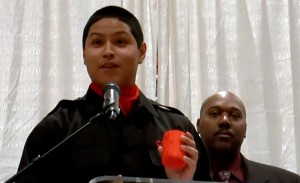
Capital Guardian Cadet Kenneth Cruz also had someone close to him in mind when he created his design.
The cylindrical ornament has an elaborate rose pattern cut into it, which casts a warm glow when a small light is placed inside. He unveiled the gift for his grandmother on stage at the DC Armory during the Dec. 13 graduation ceremony.
“I made this lantern with a rose on it for her for Christmas, but I guess I’m giving it to her now,” Kenneth announced as the crowd laughed and cheered.
Cadet Gerry Rubi said that of all the projects the 3D ThinkLink class did, making an ornament taught him the most because he was free to create his own design.
Using Moment of Inspiration modeling software, Gerry began with a simple cube. He removed all the corners, added designs to each face, scooped out the top to form a bowl and put a slot in the side for storing keys or other small items. The Cube 3D printer then turned his idea into a unique ornament that’s sure to become a family heirloom.
“It gave me a chance to play around with all the software and all the creativity I can put into it,” he said.
“One of the main things it taught me is there’s a lot of ways to do one thing,” added Gerry, who plans to become a civil engineer and received the top award, Cadet of the Cycle, at Capital Guardian’s graduation.
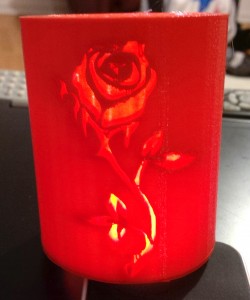
“It’s a wonderful program for the Cadets,” said Keith Hammond, Capital Guardian’s Manager of Information Systems, who helped teach the 3D classes.
“They now know that they are creative,” he continued. “Before this class, they may have had creativity bottled up inside them but because they couldn’t draw, they weren’t labeled an artist, they felt like they couldn’t be creative and they couldn’t identify themselves that way. Now, with this class and with the tools that we’re using, they can be creative and they know they have an outlet for that creativity.”
YouthQuest’s 3D ThinkLink Initiative gives at-risk teens an advantage as they enter a workforce where STEM skills are in high demand. The classes prepare students to successfully compete for a growing array of technology-related jobs that don’t require a college degree or to continue their education in one of the STEM disciplines. In addition, the program builds self-confidence and problem-solving skills that help graduates achieve their goals no matter what career path they choose.
Click here to make a donation or contact us at info@youthquestfoundation.org or (703) 234-4633.



